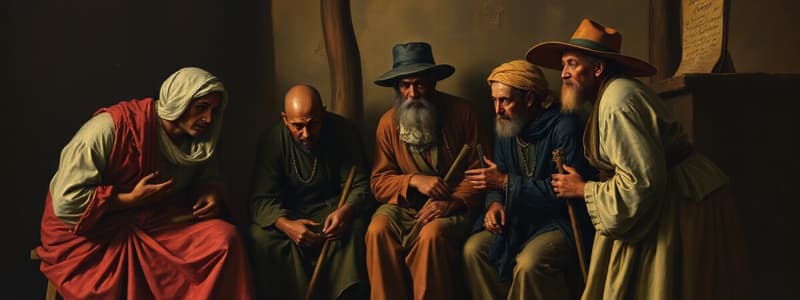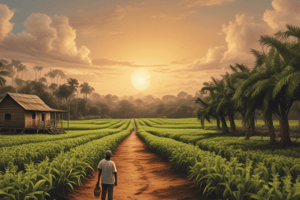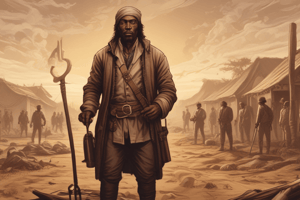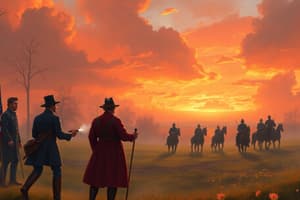Podcast
Questions and Answers
Which labor system primarily involved Europeans who often died from tropical diseases and sought land ownership?
Which labor system primarily involved Europeans who often died from tropical diseases and sought land ownership?
- Slavery
- Encomienda System
- Indentured Servant System (correct)
- The Factory System
What initiated the widespread adoption of African slavery by British and French colonies in the New World?
What initiated the widespread adoption of African slavery by British and French colonies in the New World?
- The Indentured Servant System
- The Gold Rush
- The Encomienda System
- The Sugar Revolution in Barbados (correct)
Which European power initially obtained the asiento from Spain, granting them the right to sell slaves to the New World territories?
Which European power initially obtained the asiento from Spain, granting them the right to sell slaves to the New World territories?
- France
- Netherlands
- England
- Portugal (correct)
What was the primary rationale behind the Spanish colonists' shift to utilizing African slaves in the New World?
What was the primary rationale behind the Spanish colonists' shift to utilizing African slaves in the New World?
What was the suggestion made by the Spanish Roman Catholic Priest, Las Casas, to alleviate the crisis in the New World colonies?
What was the suggestion made by the Spanish Roman Catholic Priest, Las Casas, to alleviate the crisis in the New World colonies?
What characterized the labor system of slavery in the West Indian colonies up to the 18th century?
What characterized the labor system of slavery in the West Indian colonies up to the 18th century?
How did African chiefs primarily justify their involvement in the trade of enslaved people?
How did African chiefs primarily justify their involvement in the trade of enslaved people?
What was the most common method used to obtain slaves in West Africa?
What was the most common method used to obtain slaves in West Africa?
How did the slave trade affect the population structure and social dynamics within West African communities?
How did the slave trade affect the population structure and social dynamics within West African communities?
Which European nations were predominantly involved in owning or controlling forts along the West African coast during the slave trade era?
Which European nations were predominantly involved in owning or controlling forts along the West African coast during the slave trade era?
What term was used to describe the journey of enslaved Africans from West Africa to the New World?
What term was used to describe the journey of enslaved Africans from West Africa to the New World?
What were 'barracoons' in the context of the transatlantic slave trade?
What were 'barracoons' in the context of the transatlantic slave trade?
What was the purpose of branding slaves with hot irons?
What was the purpose of branding slaves with hot irons?
Which statement accurately describes conditions during the Middle Passage?
Which statement accurately describes conditions during the Middle Passage?
What measure did some enslaved Africans take during the Middle Passage as a form of resistance?
What measure did some enslaved Africans take during the Middle Passage as a form of resistance?
What happened to slaves who died during the Middle Passage?
What happened to slaves who died during the Middle Passage?
What were the main methods used to sell slaves upon arrival in the Caribbean?
What were the main methods used to sell slaves upon arrival in the Caribbean?
Which factor contributed to the shift from logwood to mahogany production in British Honduras?
Which factor contributed to the shift from logwood to mahogany production in British Honduras?
What distinguished the work of slaves in mahogany cutting compared to those in logwood cutting?
What distinguished the work of slaves in mahogany cutting compared to those in logwood cutting?
What agricultural practices were implemented by slaves cultivating coffee to manage the land on steep hillsides?
What agricultural practices were implemented by slaves cultivating coffee to manage the land on steep hillsides?
Flashcards
Encomienda System
Encomienda System
A labor system using Amerindians, ultimately unsuccessful due to their extermination.
Indentured Servants
Indentured Servants
Europeans who worked for a fixed term, often dying from tropical diseases.
Slavery
Slavery
Involuntary servitude of West Africans, the most brutal labor system.
Africans
Africans
Signup and view all the flashcards
Asiento (1515-1580)
Asiento (1515-1580)
Signup and view all the flashcards
Why Spain imported slaves
Why Spain imported slaves
Signup and view all the flashcards
Methods of Obtaining Slaves
Methods of Obtaining Slaves
Signup and view all the flashcards
Securing Captives
Securing Captives
Signup and view all the flashcards
Slave trade
Slave trade
Signup and view all the flashcards
European Nations
European Nations
Signup and view all the flashcards
Slaver ship shelves
Slaver ship shelves
Signup and view all the flashcards
Middle Passage
Middle Passage
Signup and view all the flashcards
Conditions on Slaver Ships
Conditions on Slaver Ships
Signup and view all the flashcards
Methods of Sale: Slaves
Methods of Sale: Slaves
Signup and view all the flashcards
Logwood
Logwood
Signup and view all the flashcards
Mahogany
Mahogany
Signup and view all the flashcards
Coffee
Coffee
Signup and view all the flashcards
Cotton Production
Cotton Production
Signup and view all the flashcards
cocoa crops
cocoa crops
Signup and view all the flashcards
Study Notes
The Origins of Slavery
- Slavery has existed since the early period of mankind.
- Three types of labor systems were used or tried in the New World by the seventeenth century: the Encomienda System, the Indentured Servant System, and Slavery.
- All three were considered as or treated as slaves, but the West African experience was the worst.
The Encomienda System
- Involved the Amerindians
- It was not successful because the Indians were exterminated by the mid-sixteenth century.
The Indentured Servant System
- Involved Europeans and failed in a relatively short time for different reasons.
- Indentured Servants came from Europe and often died from tropical diseases due to lack of immunity.
- They found laboring in the sun for long hours difficult
- The contract period was for four to five years
- Servants were promised free passage back home or a grant of land at the end of their contract
- When land became unavailable, and new persons were no longer attracted by the scheme, indentured servitude proved unreliable
- Some servants ran away and broke their contracts, and some joined the Buccaneers
Slavery
- Involved the West Africans
- The Sugar Revolution began in Barbados in 1640, led by the Dutch
- The revolution quickly spread to other British and French colonies once profits were clear
- Sugar had to be cultivated on a large scale, on estates or plantations, which required a steady, reliable, efficient, and cheap source of labor
- Africans fit the criteria
Spanish Involvement in the Slave Trade
- African slavery did not start with the English in Barbados
- The Portuguese first obtained the asiento (1515-1580) from Spain to sell slaves to her New World territories
- In the early sixteenth century, Spain was the sole owner of all countries in the New World except Brazil
- The indigenous population rapidly decreased and was exterminated by the 1550s.
- Indigenous people were not suitable for hard agricultural work, proving their frailty in the mines, leading to alarming mortality rates
- Colonists in the New World decided to produce for export, leading to a need for a large, steady, and sure supply of labor
- A Spanish Roman Catholic Priest, Las Casa, suggested using African slaves to save the Indians from extinction, a recommendation that was sadly heeded
Characteristics of Slavery
- A slave is the property of his master
- Slaves bought and paid for belong slaves to his master for life.
- Enslavement meant the owner controlled his time, talent, and labor
- Children born to enslaved persons also became the property of the master
- Slavery provided a sure, steady, reliable, efficient, and cheap source of labor for the sugar estates of the West Indian colonies up to the 18th century.
Justifications for African Slavery
- The West Africans came from a tropical climate and were immune to tropical diseases
- Many captured Africans were agricultural laborers with the necessary skills for estate work
- The slaves were considered heathens and would be introduced to Christianity
- Africans were physically strong and able to endure hard work.
- They practiced a form of slavery in their homeland
Methods of Obtaining Slaves
- Raids: Setting fire to villages at night and herding the villagers
- Ethnic Wars: African chiefs bartering prisoners captured during wars
- Kidnapping: West Africans being kidnapped and sold to slave traders
The Journey to the Coast
- Captives were fastened in pairs with chains around their legs and secured in groups of fours with ropes around their legs
- A Y-shaped stick (yoke) was often fastened around their necks, with the stem resting on the shoulders of the person behind
- The coffle was guarded by armed men
- The journey to the coast was long and miserable, taking up to three months
- Each slave had to carry their own small provisions in sweltering heat and discomfort
- They were allowed to stop at nights to rest
- The weak and sick slaves were separated from the coffles and left behind to die
Effects of the Slave Trade on West Africa
- Reduction in population: 10-15 million slaves were forcibly taken from their homeland
- Families were separated, with parents and children being snatched away
- Homes were destroyed by fire during raids
- Raiders took the young and strong people, leading to a decline in the labor force and production
- Increased distrust among neighbors and friends
- Local production and crafts decreased due to the loss of skilled persons and increased demand for European consumer goods
- Guns and ammunition gave extra security to one group but provided the means to raid another group
- Some African chiefs became rich from the trade and expanded their kingdoms
- The trade opened up new routes in the interior of West Africa
- Employment was provided for locals as cohorts with white slave raiders
- Some chiefs charged taxes for the coffles to pass through their area, which helped develop their territory
- Other chiefs concentrated on the slave trade and its profits rather than their political duties
The Coast
- Slaves reached the coast but were not at their final destination
- They were received by a factor or agent, who inspected them and recorded the number of slaves
- The place the slaves were brought to was called a fort.
- Four European nations owned or controlled forts on the West African coast: the Dutch, French, English, and Portuguese
- The Portuguese were the first European nation to begin trading slaves to the Caribbean in 1515
Preparing Slaves for Transport
- Newly arrived slaves were divided into two groups: those deemed fit for the journey to the West Indies and the rejected or mackrons (those too sick or weak)
- The healthy slaves were branded with a hot iron, usually on the breast, for identification and to prevent mixing with the rejected slaves
- Slaves were kept in barracoons, small huts constantly watched by guards
The Middle Passage
- The journey from West Africa to the New World (Caribbean), was the second part of a three-legged journey, which lasted six to twelve weeks
- The minimum of six weeks was achieved if there were no raids from pirates or rival slave traders, natural disasters, or the need to stop for fresh supplies
- The maximum of twelve weeks was used if any of these events occur.
- The agent collected consumer goods, such as pots, pans, and mirrors, to exchange for more slaves
- The ship was prepared with box-like shelves, 150 cm long and 50 cm wide, stacked across the hull
- Slaves were examined before embarking, usually by the ship's surgeon
- They were packed on shelves with iron shackles around their ankles and chained to the person next to them
- Men were placed at the back, while women and younger ones were placed in the fore section
- Crewmen collected water, food supplies (yam, rice, fruits), equipment (feeding bowls, chisels, whips), and weapons (guns, knives)
Conditions During the Middle Passage
- Slaves were chained for most of the journey, leading to cramps
- Some captains allowed slaves on deck once per week for exercise, but some slaves used this as an opportunity to jump overboard
- Slaves performed bodily functions where they lay, causing a horrible stench
- Some developed sores all over their bodies
- Crew members washed the deck with water mixed with vinegar
- Cries and screams of the slaves jarred each other's nerves
- Being kept below deck caused temporary blindness when exposed to sunlight
- Slaves who refused to eat had their teeth knocked out with chisels, and food was forced into their throats
- Women slaves were often raped by crewmen
- Slaves who died were not removed until feeding time
- Both slaves and crew were in danger of catching diseases
- The Middle Passage was often termed the 'nursery of seamen' due to the high mortality rate
- Food supplies could be inadequate, causing hunger
Arrival in the Caribbean
- Slaves were sold to plantation owners at the dock after ads were posted days earlier
- Two main methods of sale: Scramble and Auction
- The best slaves were sold by auction, paraded and inspected like animals
- Unhealthy slaves were sold by the scramble method as a lottery.
- Planters/buyers rushed on deck at the sound of a gun to grab and haggle for slaves.
Logwood and Mahogany Production
- Logwood and mahogany were produced in British Guiana, Jamaica, and British Honduras (Belize): the chief supplier before Emancipation.
- Only the strong males were selected for work in the logwood and mahogany industries
Logwood
- It is a dyewood that grows plentiful in Belize and was used to dye woolen goods black, grey, purple, and dark red.
- Slaves, along with a white overseer, went to the forest for days or weeks. The slaves were armed with a machete, and axes, while the whites had guns. After labouring each day the men cooked eat, smoked tobacco together.
- This hard work was followed by getting lumber to the ports.
Mahogany
- By the 1770s, there was more logwood than needed, leading to a glut and dramatic fall in price.
- Cheaper man-made dyes decreased demand for logwood, leading settlers to shift to mahogany.
- By 1779, mahogany replaced logwood and dominated British Honduras until the mid-20th century.
- Mahogany was required for shipbuilding and cabinet making
- Slaves spent long periods away from their families due to seasonal wood cutting.
- Mahogany trees had to be found, cut, trimmed, and taken to the nearest riverside to be formed there into rafts and floated down river.
- Three groups of slaves were involved in this strenuous exercise, from ten (10) to fifty (50) slaves, coordinated by a foreman or captain.
The Huntsman
- The huntsman was a skilled slave responsible for searching for mahogany trees scattered throughout the forests, unlike logwood, which grows along riverbanks in groups
- The axe men cut down the trees and cleared a path for dragging the logs and another gang trimmed to felled trees after they had fallen.
Similarities in the Forestry Industry
- Only strong males were used
- The males stayed away from families and friends for long periods
- The tools and tasks were similar
- The presence of white supervisors and overseers was noted
Differences in the Forestry Industry
- Mahogany slaves spent a longer time in the fields
- The huntsman or skilled slave was needed
- Different organization of labor
- Logwood slaves enjoyed certain recreational activities at the end of their labors
The Work of the Slaves in Coffee Production
- Coffee was grown as an export crop during slavery in Jamaica, Dominica, Grenada, and St. Lucia
- Slaves had to burn and cut the forest to prepare the land for seedlings
- Fields marked out in even rows with an equal distance from each other. Afterwards, the land was then leveled with terraces.
- This was done for convenience of field work and to prevent soil erosion
Maintenance and Harvesting of Coffee
- Ground provisions were planted between young trees on the estates until the coffee matured, and the trees were planted to protect the plants from strong winds
- Constant weeding of the fields was done
- Reaping time occurred from the end of August to the beginning of September when slaves picked berries from dawn until midday and afterwards had a lunch break.
- They returned for labour until sunset or darkness
- At the end of each packaging session, a Negro slave driver checked the basket of each slave; anyone under the load had to receive lashes.
- Another set of slaves passed the berries through a pumping/pulping mill to remove the skin, and the naked berries were washed in a cistern while waiting for more batches.
- The slaves ensured cisterns had enough water for washing.
- After washing, the slaves then dried the product on a platform in the drying and Old and slaves, joined by the children, picked out bad berries and threw them away and stored the good ones in a granary.
- Good beans were packed for export on carts, driven by slaves to the port for shipment.
The Work of the Slaves in Cotton Production
- Cotton was grown in Dominica, Grenada, Montserrat, St. Vincent, Jamaica, and British North America (chiefly Louisiana)
- The slaves cleared land, and dug holes for cotton seeds one meter apart
- Slaves continuously weeded and fertilized the soil using animal manure while preventing soil erosion by planting other cash crops for support.
- Ripe cotton bolls were harvested by hand and slaves kept on the move to stay on the bolls and meet quota
- Each slave was given a sack to put the fluffy white bolls in, and slave drivers checked the amount and administered lashes to those below quota .
- The fibres were separated from the bolls
- The bolls were dried on a platform; old and sick slaves, and children, removed any trash while another set of slaves separated from the fibres packed them for shipping.
The Work of the Slaves in the Cocoa Industry
- Cocoa was chiefly produced in Jamaica, St. Vincent, Dominica, and Grenada.
- The slaves cleared the land and planted the cuttings directly or the seedlings were planted to a certain height before transplanting to the land.
- Cash crops were then planted around the cocoa plants crops to provide humidity.
- The pods took five and a half months to mature, which equates to two annual harvestingseasons.
- Machete-wielding slaves moved into the fields at harvest to trim.
- Usually the older or stronger slaves, they dropped said beans in baskets.
- A secondary crew used machetes to split open the pods and remove the inner contents.
- The fruit will subsequently dry and ferment for 5-7 days
- Pulp naturally separated from the beans In Grenada, to further polish the end result, slaves trampled the beans to attract consumers more effectively.
- At this point, the newly furbished harvest was ready to store.
Studying That Suits You
Use AI to generate personalized quizzes and flashcards to suit your learning preferences.




